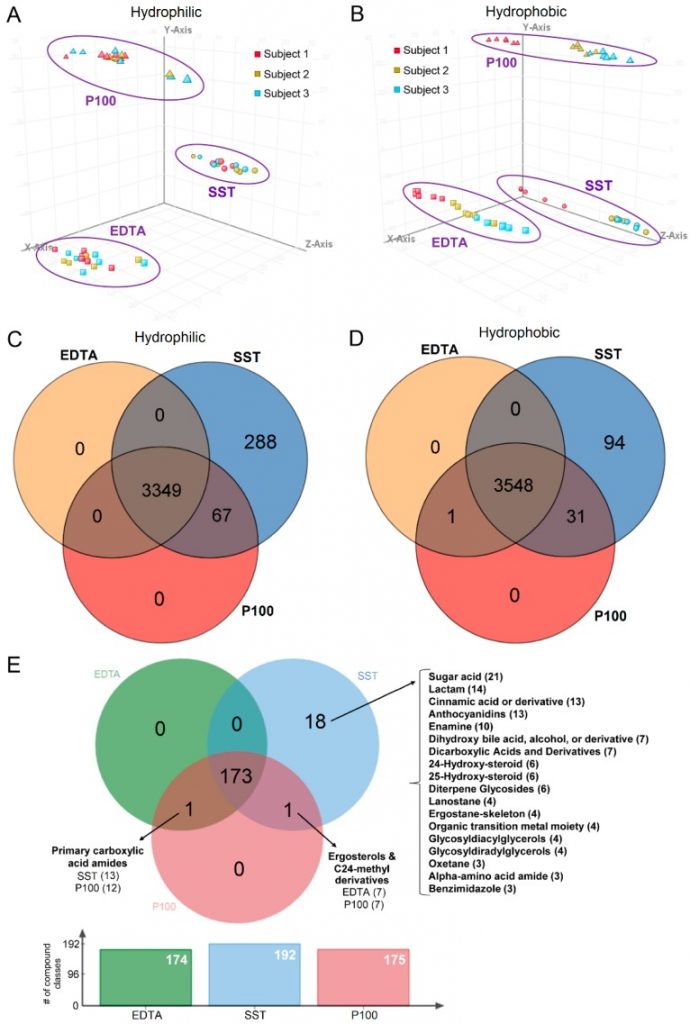Background: Metabolomics is emerging as a valuable tool in the clinical sciences. However, one of the major challenges in clinical metabolomics is of limited use standardized guidelines for sample collection and handling. In this study, we conducted a pilot analysis of serum and plasma to determine the effects of processing time and collection tubes at the metabolome.
Methods: Blood was collected in three tubes: Vacutainer serum separator tube (SST, serum), EDTA (plasma) and P100 (plasma) and stored at 4 degrees for 0, 0.5, 1, 2, 4 and 24 hours prior to centrifugation. Compounds were extracted using liquid-liquid extraction to obtain a fraction of hydrophilic and hydrophobic and analyzed using liquid chromatography-mass spectrometry.
The difference between blood collection tubes and sample processing time is evaluated (ANOVA, Bonferroni FWER ≤ 0.05 and ANOVA, Benjamini Hochberg FDR ≤ 0.1, respectively). Results: Among the serum and plasma tubes 93.5% of the compound overlaps, 382 unique compounds for serum and one unique compound to the plasma. There are 46, 50 and 86 compounds is affected by the processing time in the SST, EDTA tube and P100, respectively, including many lipids.
In contrast, 496 242 hydrophilic and hydrophobic compounds different from a collection tube. Forty-five different chemical classes include alcohols, sugars, amino acids and lipids prenol influenced by the choice of blood collection tubes.
Conclusion: Our results indicate that the choice of blood collection tubes have a significant impact on the metabolites detected and their overall abundance. Perhaps surprisingly, the variation in sample processing time has less effect than the collection tube; However, a larger sample size is needed to confirm this.

Therapeutic antibiotic serum concentrations by two blood collection methods within the pediatric patient: A comparative effectiveness trial.
venipunctures repeatedly and fingersticks to confirm serum drug concentration causing pain and discontent for pediatric patients and their families. In many organizations, the standard of care to obtain therapeutic serum drug concentration by peripheral venipuncture or fingerstick capillary, even when the patient has any peripheral intravenous catheter (PIV) or a central venous catheter (CVC).
The main objective of this study was to assess the agreement between serum tobramycin / vancomycin concentrations were collected from CVC or PIV, compared to venipuncture or fingerstick. Among patients hospitalized children (aged 3 months to 22 years), 36 paired blood samples were collected.
Through random serum vancomycin and tobramycin concentrations were compared between samples of peripheral intravenous or CVC, and venipuncture or fingerstick samples in the same patient.
A rigorous sampling protocol to obtain samples followed, including sample collection CVC / PIV before venipuncture or fingerstick, less than 2 minutes between collections of samples from different sites, and based on the volume of waste flush and strict protocol. corresponding correlation coefficient showed a substantial agreement between the CVC / PIV and venipuncture / fingerstick concentration to vancomycin (n = 17) and tobramycin (n = 19) (Rc = 0.982 for both).
Bland-Altman analysis showed overall good agreement between methods in these subjects and minimal bias. As a result, use and waste protocols flush lumen volume based-, children with venipunctures catheter may not require additional and / or fingersticks confirmation of drug concentrations while hospitalized, improve service quality and patient satisfaction.

